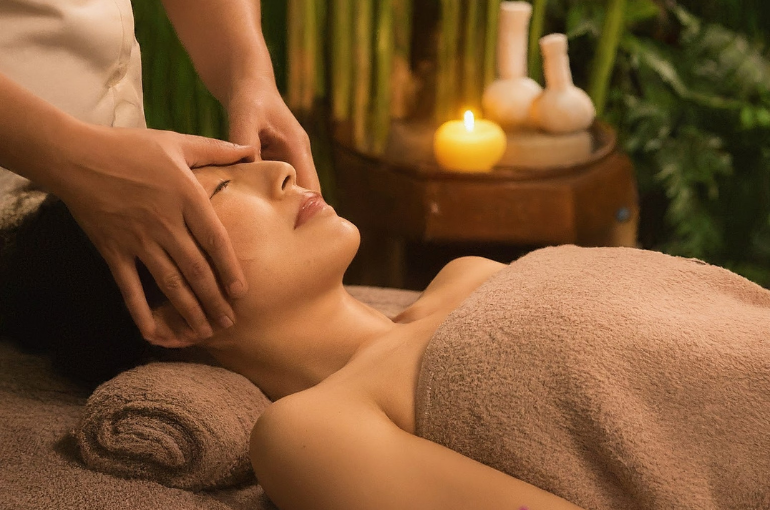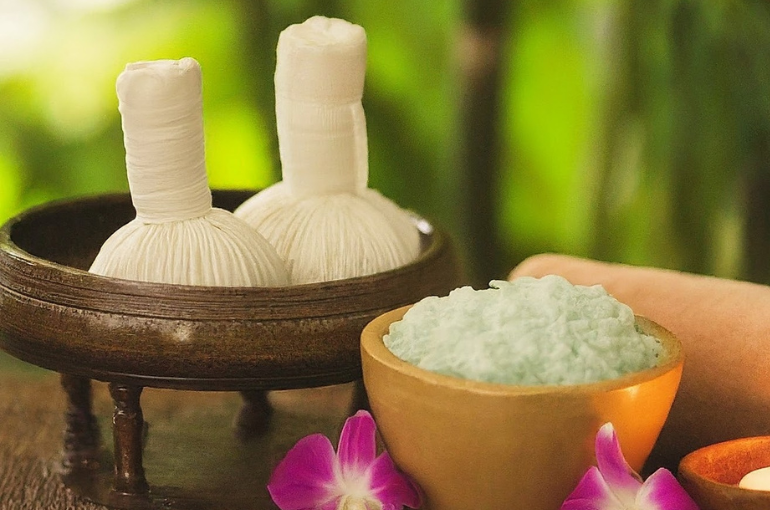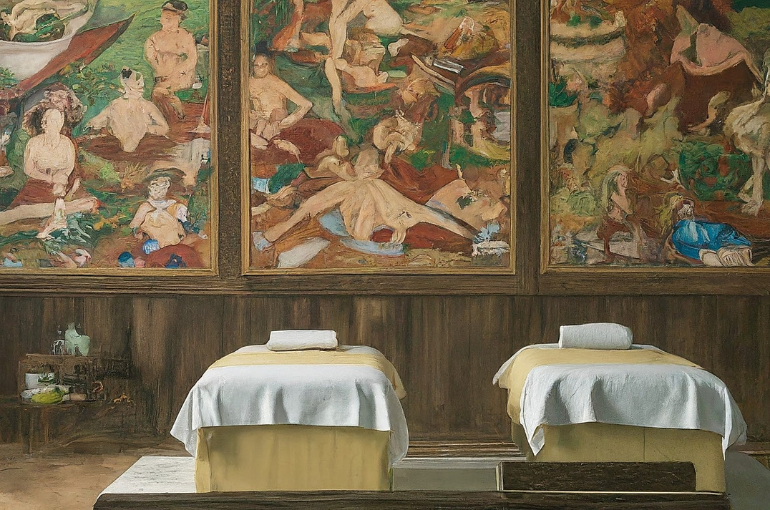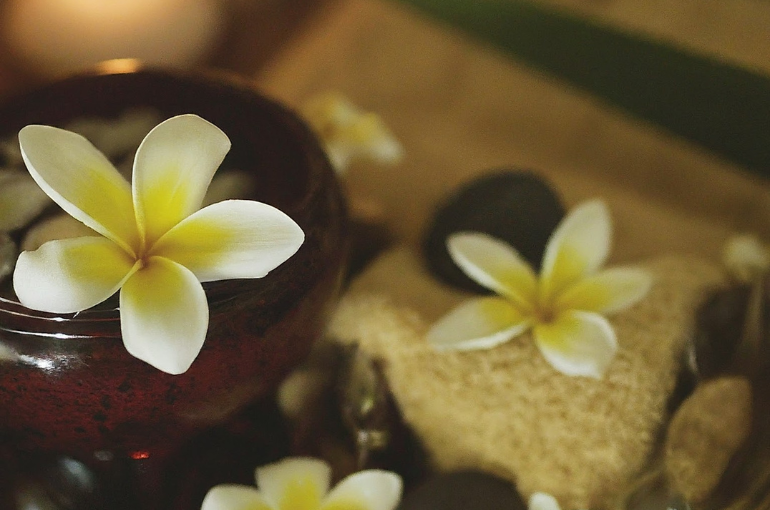In the heart of Thailand, where tradition and culture intertwined seamlessly, lies a treasure trove of ancient healing therapies that have stood the test of time. Thai spa traditions are not just a series of treatments; they are a journey into the roots of the country’s rich heritage, offering a holistic approach to wellness that transcends the ordinary. As we embark on this enlightening expedition, let’s delve into the essence of Thai spa traditions—a sacred tapestry of healing, balance, and cultural immersion.
.png)
The Foundation of Thai Spa: Nuad Thai Massage
At the core of Thai spa traditions is the renowned Nuad Thai, more commonly known as Thai massage. This ancient healing art dates back over 2,500 years and is deeply rooted in Buddhist traditions. The practice is believed to have been developed by Shivago Komarpaj, a physician to the Buddha, combining elements of Indian Ayurvedic medicine, yoga, and traditional Chinese medicine.
Thai Massage Philosophy:
The philosophy behind Thai massage goes beyond the physical—it aims to balance the body’s energy and create harmony between the body, mind, and spirit. Therapists use a combination of acupressure, passive stretching, and energy line stimulation to release tension, improve flexibility, and promote a profound sense of relaxation.
Sen Energy Lines:
At the heart of Thai massage are the “sen” energy lines, channels through which life energy, or “prana,” flows. Therapists work on these energy lines, believed to correspond to various organs and systems in the body. By unblocking and balancing the sen lines, Thai massage revitalizes the body’s energy, fostering overall well-being.
Herbal Compress Rituals: Harnessing Nature’s Bounty
Thai spa traditions extend beyond massage to incorporate herbal compress rituals, a practice deeply ingrained in Thailand’s herbal medicine heritage. The compresses, known as “luk pra kob,” are filled with a blend of therapeutic herbs, such as lemongrass, ginger, and kaffir lime. These aromatic bundles are steamed and applied to the body, offering a multi-sensory experience that combines touch, scent, and heat therapy.
SHerbal Compress Benefits:
The herbal compress ritual is renowned for its anti-inflammatory and detoxifying properties. As the warm compresses are gently pressed and rolled on the body, the herbal essences penetrate the skin, promoting relaxation, easing muscle tension, and stimulating circulation. It’s a ritual that not only nourishes the body but also pays homage to the healing power of nature.
Tok Sen: Harmonizing Vibrations for Deep Healing
A lesser-known but equally fascinating aspect of Thai spa traditions is the Tok Sen therapy. Originating from Northern Thailand and dating back centuries, Tok Sen involves the rhythmic use of a wooden mallet and wedge to create subtle vibrations that resonate through the body’s energy lines.

Energetic Healing:
Tok Sen is rooted in the belief that stagnant energy within the body can lead to discomfort and illness. The wooden tools used in Tok Sen generate vibrations that break up energy blockages, releasing tension and promoting a free flow of life energy. The therapy is both invigorating and profoundly relaxing, providing a unique and authentic Thai healing experience.
Sacred Thai Herbal Poultices: Rituals of Restoration
Thai spa traditions also embrace the use of sacred herbal poultices, known as “prai poultices.” These bundles, filled with a blend of indigenous herbs, spices, and medicinal plants, are steamed and gently pressed onto the body. The therapeutic properties of these poultices go beyond physical healing—they are deeply embedded in Thai cultural practices.
Cultural Significance:
The use of herbal poultices is not only a physical therapy but also a cultural ritual passed down through generations. The aromatic herbs, often including ingredients like turmeric and pandan leaves, carry symbolic significance and are believed to possess protective and purifying qualities. The ritual is a homage to Thailand’s agricultural roots and the reverence for the healing power of nature.
Gold-Leaf Application: The Royal Elixir of Beauty
In Thai spa traditions, gold is not just a precious metal; it is a symbol of purity, spirituality, and vitality. Gold-leaf application, known as “Thong Prakai,” is a therapeutic and aesthetic practice that traces its roots to ancient Thai royalty. The belief in the regenerative properties of gold is woven into Thai culture, and its application in spa rituals is a homage to this belief.
The Royal Elixir:
Thong Prakai involves delicately applying thin sheets of pure gold onto the skin. The gold is believed to stimulate energy flow, enhance circulation, and rejuvenate the skin. Beyond the physical benefits, the ritual is a tribute to the Thai reverence for royalty, as gold is considered a representation of the sun, a symbol of power and enlightenment.

Thai Aromatherapy: Essence of Nature’s Healing
Aromatherapy is an integral part of Thai spa traditions, drawing upon the diverse array of aromatic treasures found in the Thai landscape. Essential oils derived from indigenous herbs, flowers, and woods are expertly blended to create unique fragrances that elevate the spa experience to a sensory journey.
Signature Thai Scents:
Thai aromatherapy often features signature scents like lemongrass, jasmine, and plai (a Thai ginger variety). These scents not only induce a state of relaxation but also hold cultural significance. Lemongrass, for example, is believed to cleanse and purify, while jasmine symbolizes purity and spiritual awakening. The combination of these scents creates a sensorial voyage deeply rooted in Thai traditions.
Cultural Immersion Beyond Treatments: Spa as a Living Tradition
What sets Thai spa traditions apart is the emphasis on cultural immersion. Thai spas are not merely places of physical rejuvenation; they are living traditions that aim to educate and immerse visitors in the country’s rich heritage.
Traditional Thai Decor:
Step into a Thai spa, and you’ll likely find yourself surrounded by traditional décor. Intricate wooden carvings, silk drapes, and symbolic motifs create an ambiance that transports guests to a bygone era. The spa itself becomes a canvas that tells the story of Thailand’s cultural legacy.
Thai Hospitality:
Central to Thai spa traditions is the concept of hospitality, known as “tam jai.” Beyond the treatments, the warmth and genuine care extended by therapists are integral to the Thai spa experience. Visitors are not just recipients of therapies; they are welcomed into a space where their well-being is considered a sacred duty.
Closing the Circle: Thai Spirituality in Spa Traditions
At the heart of Thai spa traditions is the intertwining of spirituality and wellness. The practices are not isolated from the spiritual beliefs that have shaped Thai culture for centuries; they are an expression of these beliefs.
The Concept of “Ruam Thai”:
“Ruam Thai,” meaning “Thai way of life,” encompasses the spiritual principles that guide Thai spa traditions. It’s an understanding that physical well-being is inseparable from mental and spiritual balance. The spa becomes a sacred space where guests are invited to align with the rhythms of nature, the wisdom of ancient traditions, and the inherent spirituality woven into the fabric of Thai culture.
Preserving the Legacy: The Future of Thai Spa Traditions
As the world evolves and modernizes, the preservation of Thai spa traditions becomes a mission of paramount importance. Thai spa practitioners, custodians of this ancient knowledge, are dedicated to ensuring that the legacy continues to thrive, adapting to contemporary needs while staying true to its cultural roots.
Education and Training:
One crucial aspect of preserving Thai spa traditions is the ongoing education and training of therapists. Recognized institutes and schools offer comprehensive courses in traditional Thai massage, herbal therapies, and other ancient healing practices. This ensures that the knowledge is passed down to new generations of practitioners, maintaining the authenticity and effectiveness of these time-honored techniques.

Cultural Exchange Programs:
To further enrich the global understanding of Thai spa traditions, cultural exchange programs play a vital role. These initiatives facilitate the sharing of knowledge between Thai practitioners and spa professionals from around the world. By fostering cross-cultural exchanges, Thai spa traditions continue to transcend geographical boundaries, creating a global community that appreciates and respects these ancient healing arts.
Integration of Modern Wellness Trends:
While preserving tradition is paramount, Thai spa traditions also adapt to contemporary wellness trends. Integrating modern approaches to health and well-being ensures that these ancient practices remain relevant in the fast-paced, modern world. The fusion of traditional wisdom with modern techniques allows Thai spas to cater to a diverse and evolving clientele.
Sustainable Practices:
The ethos of sustainability is increasingly becoming a focal point for Thai spa traditions. Many spas are adopting eco-friendly practices, sourcing local and organic ingredients for treatments, and implementing environmentally conscious initiatives. This commitment to sustainability aligns with the traditional Thai belief in living harmoniously with nature, ensuring that the legacy of Thai spa traditions is not just preserved but also contributes positively to the planet.
Digital Outreach and Awareness:
In the digital age, creating awareness and appreciation for Thai spa traditions extends beyond physical spa spaces. Through online platforms, documentaries, and virtual experiences, the rich history, philosophy, and practices of Thai spa traditions are shared with a global audience. This digital outreach serves to demystify these ancient healing therapies and fosters a deeper understanding of their cultural significance.
Embarking on Your Own Thai Spa Journey
For those eager to embark on their own journey into Thai spa traditions, there are a few key considerations to ensure an authentic and enriching experience:
Research Authentic Spas: Seek out spas that prioritize authenticity and cultural immersion. Look for establishments that emphasize traditional treatments, employ skilled therapists, and maintain a commitment to preserving Thai spa traditions.
Ask Questions: Don't hesitate to inquire about the specific practices and philosophies incorporated into the spa's treatments. Knowledgeable therapists are often enthusiastic about sharing insights into the cultural and historical aspects of the therapies they provide.

Experience Diverse Treatments: Thai spa traditions offer a diverse range of treatments beyond the well-known Thai massage. Explore herbal compress rituals, Tok Sen therapy, gold-leaf applications, and other unique practices to gain a comprehensive understanding of the depth and breadth of Thai healing traditions.
Participate in Cultural Activities: Some spas offer cultural activities alongside traditional treatments. Participate in these activities to immerse yourself in the broader context of Thai culture, whether it's through traditional dance, cooking classes, or meditation sessions.
Respect and Mindfulness: Approach your Thai spa journey with respect and mindfulness. Recognize that these traditions are deeply rooted in cultural and spiritual significance. Embrace the experience with an open heart and a willingness to connect with the wisdom embedded in each practice.
Conclusion: A Tapestry of Healing, Tradition, and Spirituality
Thai spa traditions are not merely a collection of ancient healing therapies; they are a living tapestry woven with threads of tradition, spirituality, and a profound connection to nature. The journey into these traditions is a voyage of self-discovery, a way to harmonize the body, mind, and spirit in alignment with the Thai way of life.
As you experience the gentle touch of Thai massage, inhale the fragrant aromas of herbal compresses, and immerse yourself in the cultural richness of these traditions, you become part of a legacy that has spanned centuries. Thai spa traditions invite you to not only rejuvenate your physical being but also to connect with the timeless wisdom that has shaped the cultural fabric of Thailand—a journey into the heart of healing, tradition, and spirituality.